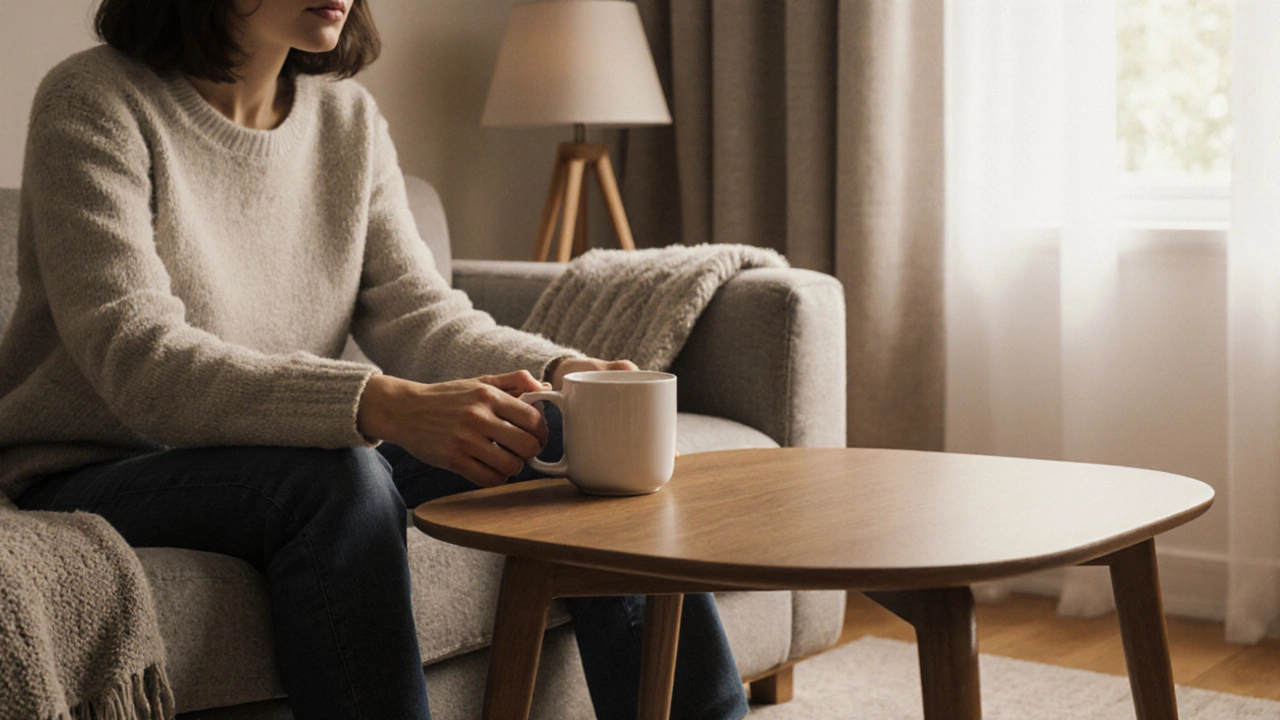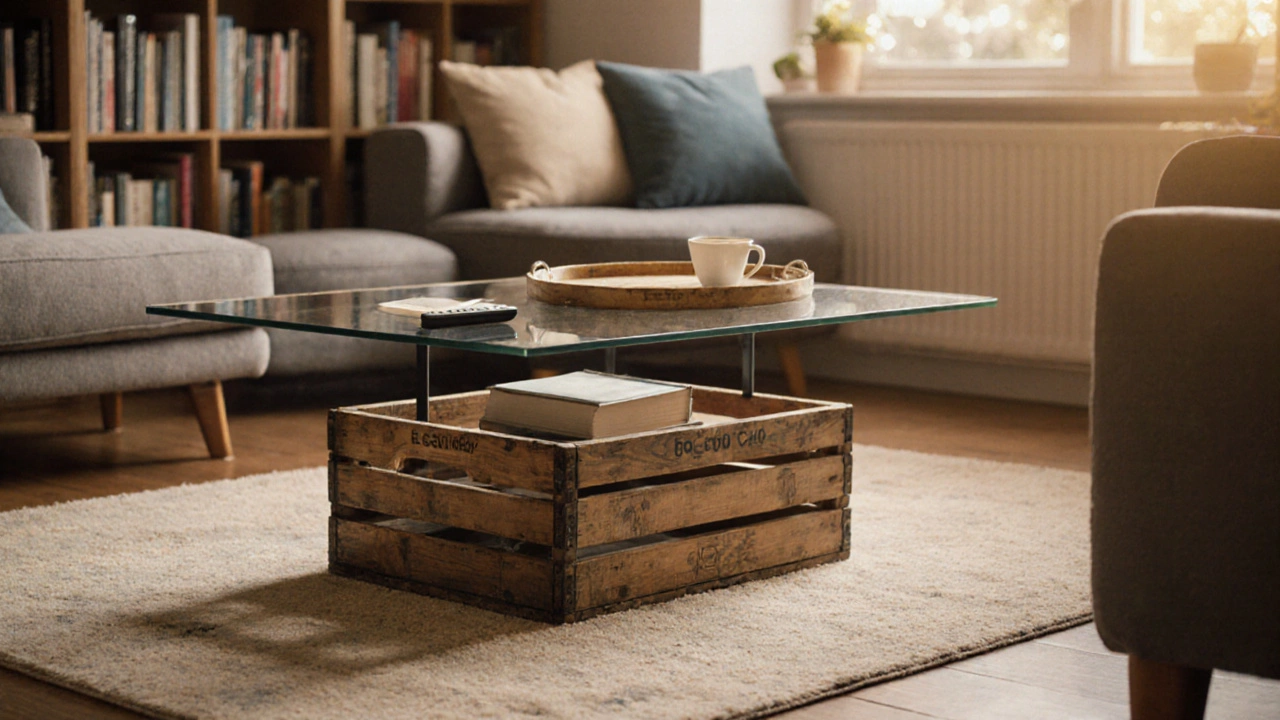
Enter your sofa's seat height to find the ideal coffee table height
Tips for adjusting your coffee table height:
Ever sat on your sofa, reached for your coffee, and had to lean forward like you’re trying to pick up a coin from the floor? That’s not just awkward-it’s a sign your coffee table might be the wrong height. It’s a simple question, but one that trips up a lot of people when setting up their living room: should a coffee table be higher than the sofa? The short answer? No. And here’s why that matters more than you think.
The standard rule of thumb is simple: your coffee table should be about the same height as your sofa seat, give or take an inch. Most sofas sit between 16 and 18 inches off the floor. That means your coffee table should land in the 16-18 inch range too.
Why does this matter? Think about how you use the space. You’re not meant to lift your arm high to grab a mug. You’re not meant to bend down too far to set one down. You want to slide your drink onto the table without straining your wrist or hunching your back. A table that’s too low forces you to reach down. One that’s too high makes it hard to rest your arms comfortably while sitting.
Real-world example: A friend of mine bought a tall, modern coffee table-22 inches high-because it looked "sleek." But every time she sat down with her tea, she had to lift her arm like she was serving a cocktail. After two weeks, she swapped it out for a 17-inch table. Instant relief. No more shoulder tension. No more spilled drinks.
A coffee table higher than your sofa isn’t just inconvenient-it can mess with your whole posture. When the table is too high, you end up hunching your shoulders to reach it. That might not seem like a big deal until you’re sitting there for an hour watching TV, and your neck starts to ache.
It also changes how you interact with the space. If the table is above seat level, you can’t rest your arms naturally on it. You lose that relaxed, lounging feeling. Instead of feeling cozy, you feel like you’re at a bar counter you didn’t sign up for.
And let’s not forget safety. A table that’s too high increases the risk of knocking things over. If you’re reaching up to grab a remote or a book, your elbow might catch the edge and send a glass flying. Lower tables are more stable, both physically and visually.
You might be thinking: "But I love that tall, sculptural table in the magazine." And you’re not wrong-design matters. But even high-end interiors stick to the 1-2 inch rule. The most stylish living rooms don’t sacrifice function for form. They blend both.
Look at brands like IKEA, West Elm, or Herman Miller. Their coffee tables are almost always within 1 inch of their matching sofa heights. Even custom pieces from top designers follow this. Why? Because comfort is non-negotiable. A beautiful table that makes you uncomfortable isn’t a design win-it’s a design fail.
There are exceptions, sure. Some modern spaces use a lower table (14-15 inches) for a more minimalist, floor-level feel. But those are intentional choices, usually paired with deeper sofas or floor cushions. They’re not accidental. They’re planned.

Don’t guess. Measure. It takes 30 seconds and saves you weeks of regret.
If your table is more than 2 inches taller than your sofa, it’s too high. If it’s more than 2 inches lower, it’s too low. The sweet spot? Match it as closely as possible.
Pro tip: If you’re buying a new table, bring a photo of your sofa with you-or note the height. Most furniture stores have this info listed online. Look for "seat height" on the sofa specs and "table height" on the coffee table specs.
You don’t need to buy a whole new set. There are smart, low-cost fixes.
One person in Birmingham told me she used a vintage wooden crate under her glass table. It added 2 inches, made the table feel more grounded, and became a conversation starter. Sometimes, the fix isn’t about perfection-it’s about creativity.

Ottomans are a popular alternative to coffee tables, especially in smaller spaces. But the same rule applies: the top of the ottoman should match your sofa’s seat height. If it’s too low, you’ll be struggling to reach your snacks. If it’s too high, your legs won’t rest comfortably.
Storage coffee tables with drawers or lift-top lids? Same deal. Measure the top surface, not the base. Even if the table has hidden storage, the working surface needs to line up with your seat.
One common mistake: people assume a lift-top table can be taller because you can raise it. But the raised position is for occasional use-like eating or working. The default, everyday height should still match your sofa.
Professional interior designers don’t guess. They use a formula: sofa seat height ± 1 inch = ideal coffee table height. That’s not a suggestion-it’s industry standard. Why? Because it’s backed by ergonomics, not aesthetics.
Even in high-end showrooms, you’ll see tables and sofas paired by height. The best furniture brands design their collections to work together. A West Elm sofa comes with a matching coffee table because they’ve already solved the height problem for you.
When you buy mismatched pieces, you’re doing the work they already did. And that work? It’s worth doing right.
Style is personal. But comfort? That’s universal. A coffee table that’s too high doesn’t just look wrong-it feels wrong. And after a few weeks of leaning, reaching, and spilling, you’ll start to hate the space you once loved.
Don’t let a trendy table ruin your lounging. Stick to the 1-inch rule. Measure your sofa. Match your table. And if you’re unsure, sit on your couch and pretend to reach for a drink. If it feels natural, you’ve got it right. If it feels like a stretch, it’s time to rethink.
Your living room should be a place you sink into-not a place you adjust for.
Yes, a coffee table can be slightly lower than the sofa-by up to 1 inch-and it still works well. Many modern and minimalist designs use lower tables (around 14-16 inches) to create a more relaxed, floor-level feel. Just make sure you can still reach your drinks without bending too far. If you’re using a deep sofa with plush cushions, a lower table can even feel more inviting.
Yes. Even if your sofa has a hard seat or no cushion, measure from the floor to the top of the seat frame. That’s your reference point. The coffee table should still match that height within 1 inch. A hard seat doesn’t change how your body reaches for objects-it just means you’ll feel the discomfort more if the table’s off.
Shape doesn’t affect height rules, but it can affect usability. A long rectangular table works best with a sectional or long sofa. A round or oval table is better for smaller spaces or when you have kids or pets, because it reduces the chance of bumping into sharp corners. But no matter the shape, the height should still match your sofa seat.
Absolutely. Many people use two smaller tables-one on each side of a sofa-to create balance and flexibility. Just make sure both tables are within 1 inch of your sofa’s height. If one is higher than the other, it’ll look uneven and feel unbalanced when you reach for something.
Yes, and it’s actually common. Armrests are usually higher than the seat cushion-often by 3 to 6 inches. So a coffee table that’s the same height as the seat will naturally be lower than the armrests. That’s fine. You’re not supposed to rest your arms on the coffee table. You’re supposed to rest them on the sofa’s arms. The table is for your drinks, books, or remote.
Write a comment